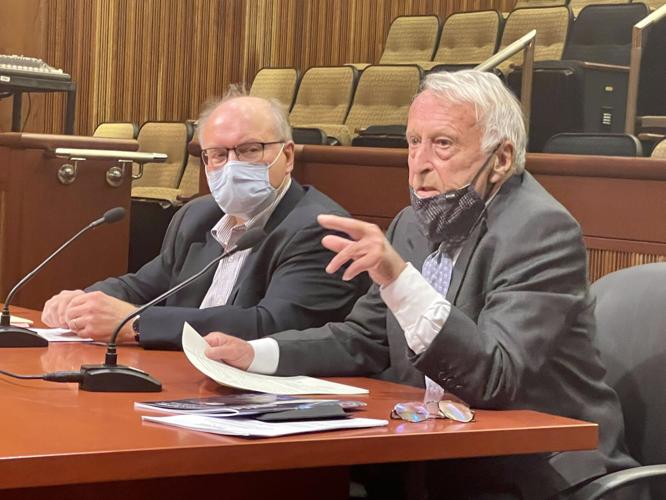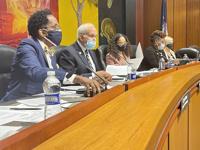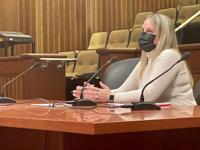ALBANY — New York women and minority groups struggling to balance work and family caregiving forced them to leave the workforce or change industries, contributing to the state’s record job loss and labor decline during the COVID-19 pandemic, officials said Monday.
Lawmakers in the Assembly Labor Committee, Emerging Workforce Subcommittee and the Women’s Issues Task Force listened to and questioned 10 panels of witnesses for several hours Monday to focus on policy goals and budget priorities to address issues plaguing the New York workforce and connect workers with job opportunities to meet labor demands amid the pandemic.
“The COVID-19 pandemic has continued to have a devastating impact on the economy and far-reaching impacts for workers in New York state,” said Assemblymember Latoya Joyner, D-Bronx, Assembly Labor Committee chairwoman. “Shutdowns and working conditions resulting from the pandemic have also caused many displaced workers to leave their previous employment to seek different types of work, leading to labor shortages in industries that were once considered essential at the height of the pandemic.”
About 8.6 million New Yorkers are employed, with 660,000 state residents unemployed to date, State Department of Labor Commissioner Roberta Reardon said.
“You see this playing out across the nation and the kitchen table,” she said.
About 375,000 jobs are available in the state — a record high.
The state has lost about 875,000 jobs since the start of the coronavirus pandemic 20 months ago in March 2020.
The state saw job loss of 8.9% in September — nearly three times greater than the national decline, and nearly 18.5% of the national pandemic jobs deficit, said James Parrott, the director of economic and fiscal policies with the Center for New York City Affairs at The New School.
“Our job deficit far exceeds that of every other [U.S.] state as of September,” Parrott said.
The state has an unemployment rate of 7.1%.
“New York state’s current unemployment rate understates the real extent of unemployment to exclude those who have left the labor force, and it doesn’t reflect the fact that many have returned to work or working only part-time,” Parrott said.
Officials cited countless reasons for the labor shift caused by the COVID-19 pandemic, which pushed New Yorkers looking for work and in different industries, with an unprecedented increase in job automation, job displacement, a widening skills gap between businesses and employees and continuing changes in employees’ needs and expectations.
“Businesses were clear, they are not seeing enough job seekers who are qualified,” Reardon said of communication, management and critical thinking skills.
Job seekers want higher wages, more flexibility, a better work-life balance and job security.
Businesses need guidance and resources to adapt to the changing labor landscape, the commissioner said.
Federal officials have disagreed about pandemic-related assistance, including additional unemployment insurance benefits, over the last 20 months. Federal and state Republican leaders largely continue to argue the workforce issues are tied to the increased benefits and programs, dissuading people to return to work.
The state’s 875,000 fewer jobs partnered with hundreds of thousands of New Yorkers reporting growing economic hardship, and a state with a job deficit three times higher than the national average, Parrott told lawmakers, would mean a surge in unemployed workers, and not by choice.
“Can it really be that New Yorkers are three times more likely to choose to stay home and their counterparts nationally?” he said. “Most recent report on this from the U.S. Bureau of Labor Statistics indicates that among all states, in August, New York had the third-lowest job openings rate, one of the lowest new hires grades and the second-lowest quit rate among all states.”
The pandemic’s ongoing economic impacts continue to be lopsided, with high-income earners who did not lose their employment seeing pay raises while a majority of low-wage workers and small-business owners work to recover.
“State tax revenues have rebounded and Wall Street and big-tech companies are flourishing,” Parrott said. “The continuing economic hardships experienced by a substantial number of low-income New Yorkers all across the state calls for a more targeted response to connecting these workers with promising job openings and providing additional skills training or education where necessary.”
Parrott encouraged lawmakers to provide targeted wage subsidies to low-wage workers and small businesses most in need with bolstered state investment in workforce training programs to fill job openings as opposed to state-funded unemployment assistance.
About 863,000 women left the workforce nationwide in September — the largest drop in women’s participation in the U.S. labor force since the pandemic began, said witness Meghan Racklin, a staff attorney with legal nonprofit A Better Balance.
Racklin pleaded with lawmakers to update the state’s Paid Family Leave and temporary disability insurance laws. The state’s benefit level for temporary disability insurance has not increased 1989, standing at a maximum of $170 a week — significantly less than the state paid family leave benefit level.
“As a result, a pregnant worker with a high-risk pregnancy who needs TDI prior to giving birth is treated far worse than a parent on paid family leave,” Racklin said.
The state’s Paid Family Leave benefits need to become easily transferrable from one job to another, Racklin told lawmakers, adding they must vote to remove the program’s waiting period so employees can more easily access the benefit and encourage women and family caregivers to remain in the workforce.













